Android WIFI 模块解析
Posted bug樱樱
tags:
篇首语:本文由小常识网(cha138.com)小编为大家整理,主要介绍了Android WIFI 模块解析相关的知识,希望对你有一定的参考价值。
android WIFI 模块解析(2)
书接上文,这一章接着分析wifi模块的Hal层的调用逻辑.
public String setupInterfaceForClientMode(boolean lowPrioritySta,
@NonNull InterfaceCallback interfaceCallback)
synchronized (mLock)
//启动hal层.
if (!startHal())
Log.e(TAG, "Failed to start Hal");
mWifiMetrics.incrementNumSetupClientInterfaceFailureDueToHal();
return null;
//启动wpa_supplicant
if (!startSupplicant())
Log.e(TAG, "Failed to start supplicant");
mWifiMetrics.incrementNumSetupClientInterfaceFailureDueToSupplicant();
return null;
Iface iface = mIfaceMgr.allocateIface(Iface.IFACE_TYPE_STA);
if (iface == null)
Log.e(TAG, "Failed to allocate new STA iface");
return null;
iface.externalListener = interfaceCallback;
iface.name = createStaIface(iface, lowPrioritySta);
if (TextUtils.isEmpty(iface.name))
Log.e(TAG, "Failed to create STA iface in vendor HAL");
mIfaceMgr.removeIface(iface.id);
mWifiMetrics.incrementNumSetupClientInterfaceFailureDueToHal();
return null;
if (mWificondControl.setupInterfaceForClientMode(iface.name) == null)
Log.e(TAG, "Failed to setup iface in wificond on " + iface);
teardownInterface(iface.name);
mWifiMetrics.incrementNumSetupClientInterfaceFailureDueToWificond();
return null;
if (!mSupplicantStaIfaceHal.setupIface(iface.name))
Log.e(TAG, "Failed to setup iface in supplicant on " + iface);
teardownInterface(iface.name);
mWifiMetrics.incrementNumSetupClientInterfaceFailureDueToSupplicant();
return null;
iface.networkObserver = new NetworkObserverInternal(iface.id);
if (!registerNetworkObserver(iface.networkObserver))
Log.e(TAG, "Failed to register network observer on " + iface);
teardownInterface(iface.name);
return null;
mWifiMonitor.startMonitoring(iface.name);
// Just to avoid any race conditions with interface state change callbacks,
// update the interface state before we exit.
onInterfaceStateChanged(iface, isInterfaceUp(iface.name));
initializeNwParamsForClientInterface(iface.name);
Log.i(TAG, "Successfully setup " + iface);
return iface.name;
这是上一章中贴出的最后一个函数,本章我们重点分析startHal()函数和startSupplicant()函数.
startHal
调用过程
我们先追逐一下其代码过程
startHal
/** Helper method invoked to start supplicant if there were no ifaces */
private boolean startHal()
synchronized (mLock)
if (!mIfaceMgr.hasAnyIface())
//判断其是否当前的设备供应商Hal层是否可用
if (mWifiVendorHal.isVendorHalSupported())
//启动设备Hal
if (!mWifiVendorHal.startVendorHal())
Log.e(TAG, "Failed to start vendor HAL");
return false;
else
Log.i(TAG, "Vendor Hal not supported, ignoring start.");
return true;
WifiVendorHal
这个类注释是厂商hal层对HIDL的支持,HIDL的发音hide-l.后文专门解释一下这个东西
/**
* Vendor HAL via HIDL
*/
public class WifiVendorHal
...
/**
* Bring up the HIDL Vendor HAL.
* @return true on success, false otherwise.
*/
public boolean startVendorHal()
synchronized (sLock)
// 在这里启动
if (!mHalDeviceManager.start())
mLog.err("Failed to start vendor HAL").flush();
return false;
mLog.info("Vendor Hal started successfully").flush();
return true;
...
HalDeviceManager
/**
* Handles device management through the HAL (HIDL) interface.
*/
public class HalDeviceManager
/**
* Attempts to start Wi-Fi (using HIDL). Returns the success (true) or failure (false) or
* the start operation. Will also dispatch any registered ManagerStatusCallback.onStart() on
* success.
*
* Note: direct call to HIDL.
*/
public boolean start()
return startWifi();
private boolean startWifi()
if (VDBG) Log.d(TAG, "startWifi");
synchronized (mLock)
try
if (mWifi == null)
Log.w(TAG, "startWifi called but mWifi is null!?");
return false;
else
int triedCount = 0;
while (triedCount <= START_HAL_RETRY_TIMES)
//在这里
WifiStatus status = mWifi.start();
if (status.code == WifiStatusCode.SUCCESS)
initIWifiChipDebugListeners();
managerStatusListenerDispatch();
if (triedCount != 0)
Log.d(TAG, "start IWifi succeeded after trying "
+ triedCount + " times");
return true;
else if (status.code == WifiStatusCode.ERROR_NOT_AVAILABLE)
// Should retry. Hal might still be stopping.
Log.e(TAG, "Cannot start IWifi: " + statusString(status)
+ ", Retrying...");
try
Thread.sleep(START_HAL_RETRY_INTERVAL_MS);
catch (InterruptedException ignore)
// no-op
triedCount++;
else
// Should not retry on other failures.
Log.e(TAG, "Cannot start IWifi: " + statusString(status));
return false;
Log.e(TAG, "Cannot start IWifi after trying " + triedCount + " times");
return false;
catch (RemoteException e)
Log.e(TAG, "startWifi exception: " + e);
return false;
在这里我们看到mWifi这个对象去调用了start()函数通过hal层去启动与内核通信.那么mWifi这个对象在何时创建.
import android.hardware.wifi.V1_0.IWifi;
/**
* Wrapper function to access the HIDL services. Created to be mockable in unit-tests.
*/
protected IWifi getWifiServiceMockable()
try
return IWifi.getService();
catch (RemoteException e)
Log.e(TAG, "Exception getting IWifi service: " + e);
return null;
我们看下IWifi到底是何物
IWifi
package android.hardware.wifi@1.0;
import IWifiChip;
import IWifiEventCallback;
/**
* This is the root of the HAL module and is the interface returned when
* loading an implementation of the Wi-Fi HAL. There must be at most one
* module loaded in the system.
*/
interface IWifi
/**
* Requests notifications of significant events for the HAL. Multiple calls to
* this must register multiple callbacks each of which must receive all
* events. |IWifiEventCallback| object registration must be independent of the
* state of the rest of the HAL and must persist though stops/starts. These
* objects must be deleted when the corresponding client process is dead.
*
* @param callback An instance of the |IWifiEventCallback| HIDL interface
* object.
* @return status WifiStatus of the operation.
* Possible status codes:
* |WifiStatusCode.SUCCESS|,
* |WifiStatusCode.UNKNOWN|
*/
@entry
@callflow(next="*")
registerEventCallback(IWifiEventCallback callback)
generates (WifiStatus status);
/**
* Get the current state of the HAL.
*
* @return started true if started, false otherwise.
*/
isStarted() generates (bool started);
/**
* Perform any setup that is required to make use of the module. If the module
* is already started then this must be a noop.
* Must trigger |IWifiEventCallback.onStart| on success.
*
* @return status WifiStatus of the operation.
* Possible status codes:
* |WifiStatusCode.SUCCESS|,
* |WifiStatusCode.NOT_AVAILABLE|,
* |WifiStatusCode.UNKNOWN|
*/
@entry
@callflow(next="registerEventCallback", "start", "stop", "getChip")
start() generates (WifiStatus status);
/**
* Tear down any state, ongoing commands, etc. If the module is already
* stopped then this must be a noop. If the HAL is already stopped or it
* succeeds then onStop must be called. After calling this all IWifiChip
* objects will be considered invalid.
* Must trigger |IWifiEventCallback.onStop| on success.
* Must trigger |IWifiEventCallback.onFailure| on failure.
*
* Calling stop then start is a valid way of resetting state in the HAL,
* driver, firmware.
*
* @return status WifiStatus of the operation.
* Possible status codes:
* |WifiStatusCode.SUCCESS|,
* |WifiStatusCode.NOT_STARTED|,
* |WifiStatusCode.UNKNOWN|
*/
@exit
@callflow(next="registerEventCallback", "start", "stop")
stop() generates (WifiStatus status);
...
;
WIFI HAL 总结
IWifi.hal文件位于hardware/interfaces/wifi/1.0/,这个取决于厂商使用的版本.前文在HalDeviceManager使用IWifi.getService();这样的方式来获取服务,那么我们就会很疑惑,服务注册在何处,代码在何方.
问题的关键呢就在这个hal文件中,它通过BP文件会生成Java和C++的模板代码,在bp文件中有不同的配置项配置它的生成代码.也可以自己通过命令去生成代码.
hidl-gen工具路径在代码路径下out/host/linux-x86/bin/路径下.可以通过hidl-gen -help命令查看对于参数.但是这个东西在android 10有被google抛弃,改用了AIDL方式.所以对这块就没有更深入的探究下去.
简单的贴一下编译后的C++的注册代码
int main(int /*argc*/, char** argv)
android::base::InitLogging(
argv, android::base::LogdLogger(android::base::SYSTEM));
LOG(INFO) << "Wifi Hal is booting up...";
configureRpcThreadpool(1, true /* callerWillJoin */);
// Setup hwbinder service 这个是1_2版本的注册代码,不是上文中的1_0的版本,但是注册的地吗几乎是一致的,作为参考查看
android::sp<android::hardware::wifi::V1_2::IWifi> service =
new android::hardware::wifi::V1_2::implementation::Wifi(
std::make_shared<WifiLegacyHal>(),
std::make_shared<WifiModeController>(),
std::make_shared<WifiFeatureFlags>());
CHECK_EQ(service->registerAsService(), android::NO_ERROR)
<< "Failed to register wifi HAL";
joinRpcThreadpool();
LOG(INFO) << "Wifi Hal is terminating...";
return 0;
在这一块的参考资料确实有点少,理解也不够深入,举个例子
/**
* Perform any setup that is required to make use of the module. If the module
* is already started then this must be a noop.
* Must trigger |IWifiEventCallback.onStart| on success.
*
* @return status WifiStatus of the operation.
* Possible status codes:
* |WifiStatusCode.SUCCESS|,
* |WifiStatusCode.NOT_AVAILABLE|,
* |WifiStatusCode.UNKNOWN|
*/
android.hardware.wifi.V1_0.WifiStatus start()
throws android.os.RemoteException;
上面是tart()函数生成的JAvA代码,下文是生成的C++的代码,没有搞清楚在C++代码start函数中的 _hidl_cb参数从和而来,这个参数在后面的实际调用中也有用到.感兴趣的朋友,可以自己在深入的看下去,如果有答案了,有条件的话也告诉我一下.
/**
* Perform any setup that is required to make use of the module. If the module
* is already started then this must be a noop.
* Must trigger |IWifiEventCallback.onStart| on success.
*
* @return status WifiStatus of the operation.
* Possible status codes:
* |WifiStatusCode.SUCCESS|,
* |WifiStatusCode.NOT_AVAILABLE|,
* |WifiStatusCode.UNKNOWN|
*/
virtual ::android::hardware::Return<void> start(start_cb _hidl_cb) = 0;
startSupplicant
在成功的通过HAL层代码启动wifi设备之后,代码就可以去调用了startSupplicant()函数,那么这个东西是干什么的,HAL层对外提供了start,stop,getChipIds,和注册回调函数等方案,其他并未提供,也就是说只有硬件相关的型号,和启动,暂停等关键函数,关于wifi的链接维护等函数并未提供,startSupplicant启动的就是wpa_sulicant.
wpa_sulicant
wpa_sulicant是一个开源项目,被google经过修改加入到Android系统当中.主要支持WPA,EAP,无线网卡和驱动.有兴趣致力于研究wifi相关的朋友可以研究一下这个东西,本文浅尝辄止.
调用过程
startSupplicant
/** Helper method invoked to start supplicant if there were no STA ifaces */
private boolean startSupplicant()
synchronized (mLock)
if (!mIfaceMgr.hasAnyStaIface())
//这里
if (!mWificondControl.enableSupplicant())
Log.e(TAG, "Failed to enable supplicant");
return false;
if (!waitForSupplicantConnection())
Log.e(TAG, "Failed to connect to supplicant");
return false;
if (!mSupplicantStaIfaceHal.registerDeathHandler(
new SupplicantDeathHandlerInternal()))
Log.e(TAG, "Failed to register supplicant death handler");
return false;
return true;
/**
* Enable wpa_supplicant via wificond.
* @return Returns true on success.
*/
public boolean enableSupplicant()
if (!retrieveWificondAndRegisterForDeath())
return false;
try
//这里
return mWificond.enableSupplicant();
catch (RemoteException e)
Log.e(TAG, "Failed to enable supplicant due to remote exception");
return false;
可以看到最终启动wpa_supplicant使用一个wificond的一个对象.我们看下它是怎么获取的.
WifiInjector
private static final String WIFICOND_SERVICE_NAME = "wificond";
public IWificond makeWificond()
// We depend on being able to refresh our binder in WifiStateMachine, so don't cache it.
IBinder binder = ServiceManager.getService(WIFICOND_SERVICE_NAME);
return IWificond.Stub.asInterface(binder);
也是通过binder的形式进行通信,那么wificond服务是何时注册到ServiceManager中的呢.接着往下看
wificond
include $(CLEAR_VARS)
LOCAL_MODULE := wificond
LOCAL_CPPFLAGS := $(wificond_cpp_flags)
LOCAL_INIT_RC := wificond.rc
LOCAL_C_INCLUDES := $(wificond_includes)
LOCAL_SRC_FILES := \\
main.cpp
LOCAL_SHARED_LIBRARIES := \\
android.hardware.wifi.offload@1.0 \\
libbinder \\
libbase \\
libcutils \\
libhidlbase \\
libhidltransport \\
libminijail \\
libutils \\
libwifi-system \\
libwifi-system-iface
LOCAL_STATIC_LIBRARIES := \\
libwificond
include $(BUILD_EXECUTABLE)
这个是system/connectivity/wificond/android.mk中的一段,大意就是编译一个Natvie C的可执行文件,module为wificond.
在对应的main.cpp我们找到了注册服务的代码
int main(int argc, char** argv)
...
RegisterServiceOrCrash(server.get());
event_dispatcher->Poll();
LOG(INFO) << "wificond is about to exit";
return 0;
void RegisterServiceOrCrash(const android::sp<android::IBinder>& service)
android::sp<android::IServiceManager> sm = android::defaultServiceManager();
CHECK_EQ(sm != NULL, true) << "Could not obtain IServiceManager";
//这里addService到ServiceManager中
CHECK_EQ(sm->addService(android::String16(kServiceName), service),
android::NO_ERROR);
那么它是在什么时候执行这个main.cpp呢,跟同事讨论这个问题时,猜测
- 在开机流程中有一段代码是会执行所有服务的
main()函数.(未经确认,我还没有仔细的梳理过开机流程).
不过我在init.zygote文件找到这样一段脚本文件
onrestart restart audioserver
onrestart restart cameraserver
onrestart restart media
onrestart restart netd
onrestart restart wificond
如果和推测一致呢就是在开机流程中已经执行了,在这里用restart确保其一定被启动.负责无法理解要用 restart去启动.好,解释了服务在何时注册,何时启动之后,我们接着往下看他是怎么启动wpa_supplicant.
Status Server::enableSupplicant(bool* success)
//这里,接着寻找 supplicant_manager_
*success = supplicant_manager_->StartSupplicant();
return Status::ok();
supplicant_manager
- 代码路径
frameworks/opt/net/wifi/libwifi_system/supplicant_manager.cpp
在这里呢就简单的分析一下它的启动代码
namespace
const char kSupplicantInitProperty[] = "init.svc.wpa_supplicant";
const char kSupplicantServiceName[] = "wpa_supplicant";
// namespace
bool SupplicantManager::StartSupplicant()
char supp_status[PROPERTY_VALUE_MAX] = '\\0';
int count = 200; /* wait at most 20 seconds for completion */
const prop_info* pi;
unsigned serial = 0;
/* Check whether already running */
//获取property属性 赋值给 supp_status ,字符串对比判断其是否已经启动,如果启动就
//return
if (property_get(kSupplicantInitProperty, supp_status, NULL) &&
strcmp(supp_status, "running") == 0)
return true;
/*
* Get a reference to the status property, so we can distinguish
* the case where it goes stopped => running => stopped (i.e.,
* it start up, but fails right away) from the case in which
* it starts in the stopped state and never manages to start
* running at all.
*/
//找到属性值索引
pi = __system_property_find(kSupplicantInitProperty);
if (pi != NULL)
//拿到其序号
serial = __system_property_serial(pi);
//启动 服务
property_set("ctl.start", kSupplicantServiceName);
//让出自己的CPU控制权,将自己排到CPU序列队尾
sched_yield();
while (count-- > 0)
if (pi == NULL)
//空的话就重新获取获取一下索引
pi = __system_property_find(kSupplicantInitProperty);
if (pi != NULL)
/*
* property serial updated means that init process is scheduled
* after we sched_yield, further property status checking is based on this
*/
//用现在的序号和之前的序号做对比
if (__system_property_serial(pi) != serial)
//有改变就取出
__system_property_read(pi, NULL, supp_status);
//对比字符串,如果已经在运行就 return
if (strcmp(supp_status, "running") == 0)
return true;
else if (strcmp(supp_status, "stopped") == 0)
return false;
usleep(100000);
return false;
理解上面的代码主要需要了解关于android系统中property相关的知识.例如ctl.start是启动服务等等. 这个百度一下就有很多相关的文章,就不贴链接了.
总结
接下来就不去写关于wifi链接和扫描等相关内容了,其代码量之大,平常需要改动的需求也是非常少的,有兴趣了解的根据梳理的流程自行查看.接下来我们画一个图,来表示整个流程中我们重点关注的模块,和其主要功能.
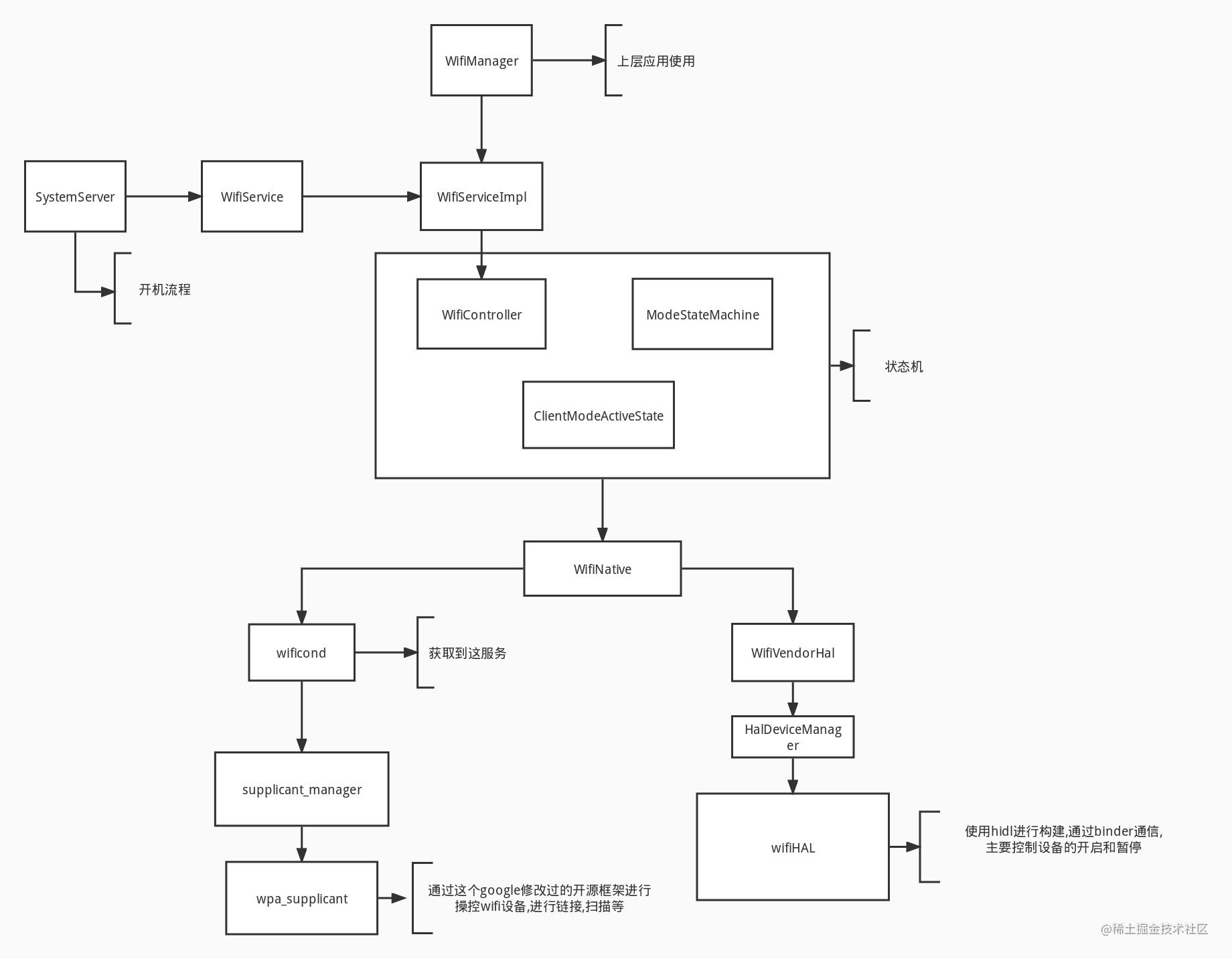
闲聊一些
-
Java层主要优化方向可能放在开机流程,不过提前启动应该收效甚微。
-
状态机优化,这个从Google不同版本的源代码就可以看出,Google自己在新的版本中也在不断的优化关于状态机的模块。 理解上层的逻辑代码也必须了解状态机。
-
hal层主要控制了硬件设备的启动和暂停。
-
wpa_supplicant,关注这个模块应该是深入了解和优化,也是一个开源项目。(留待以后深入研究。)
-
后续的计划呢,可能重心要放在优化方向。关于binder的文章还要再推迟,不知道今年能不能完成了。
文末
要想成为架构师,那就不要局限在编码,业务,要会选型、扩展,提升编程思维。此外,良好的职业规划也很重要,学习的习惯很重要,但是最重要的还是要能持之以恒,任何不能坚持落实的计划都是空谈。
如果你没有方向,这里给大家分享一套由阿里高级架构师编写的《Android八大模块进阶笔记》,帮大家将杂乱、零散、碎片化的知识进行体系化的整理,让大家系统而高效地掌握Android开发的各个知识点。
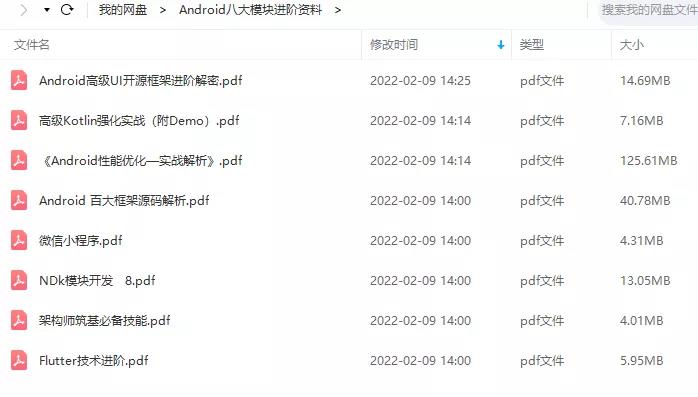
相对于我们平时看的碎片化内容,这份笔记的知识点更系统化,更容易理解和记忆,是严格按照知识体系编排的。
一、架构师筑基必备技能
1、深入理解Java泛型
2、注解深入浅出
3、并发编程
4、数据传输与序列化
5、Java虚拟机原理
6、高效IO
……
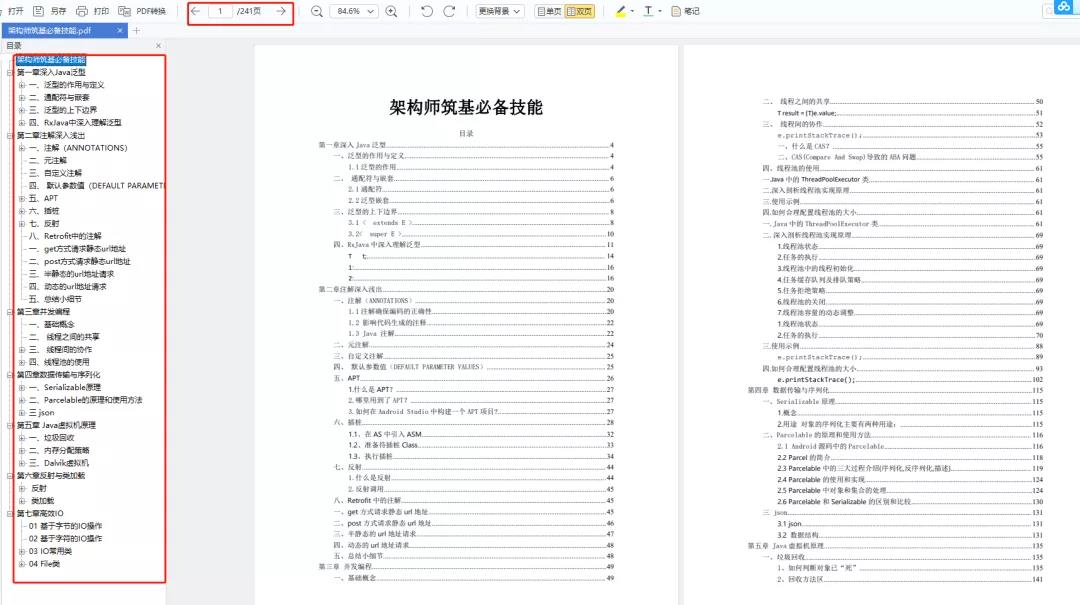
二、Android百大框架源码解析
1.Retrofit 2.0源码解析
2.Okhttp3源码解析
3.ButterKnife源码解析
4.MPAndroidChart 源码解析
5.Glide源码解析
6.Leakcanary 源码解析
7.Universal-lmage-Loader源码解析
8.EventBus 3.0源码解析
9.zxing源码分析
10.Picasso源码解析
11.LottieAndroid使用详解及源码解析
12.Fresco 源码分析——图片加载流程
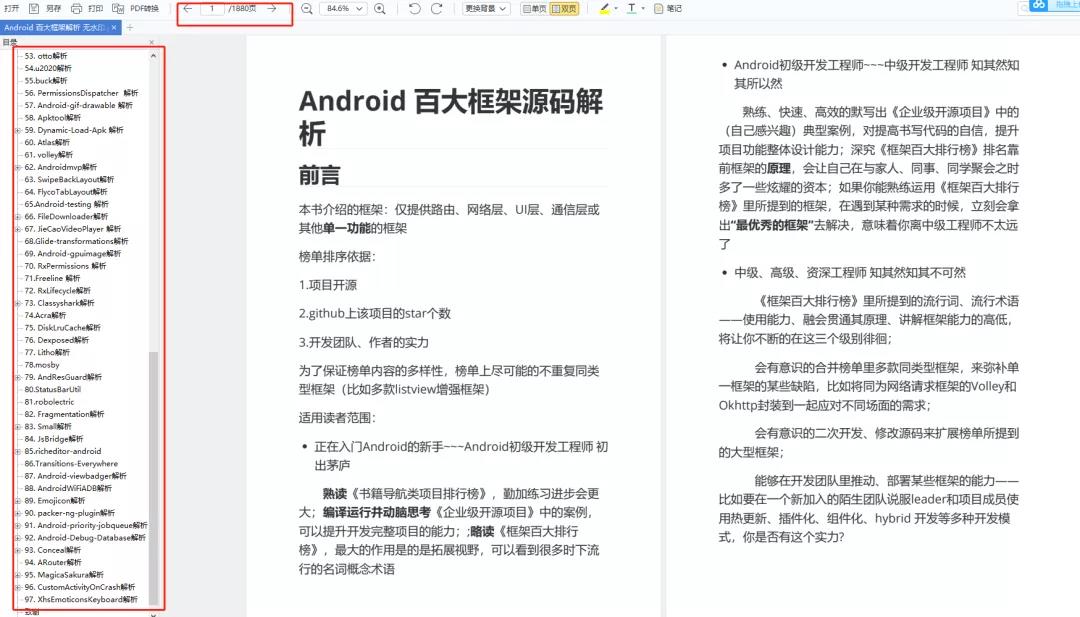
三、Android性能优化实战解析
- 腾讯Bugly:对字符串匹配算法的一点理解
- 爱奇艺:安卓APP崩溃捕获方案——xCrash
- 字节跳动:深入理解Gradle框架之一:Plugin, Extension, buildSrc
- 百度APP技术:Android H5首屏优化实践
- 支付宝客户端架构解析:Android 客户端启动速度优化之「垃圾回收」
- 携程:从智行 Android 项目看组件化架构实践
- 网易新闻构建优化:如何让你的构建速度“势如闪电”?
- …
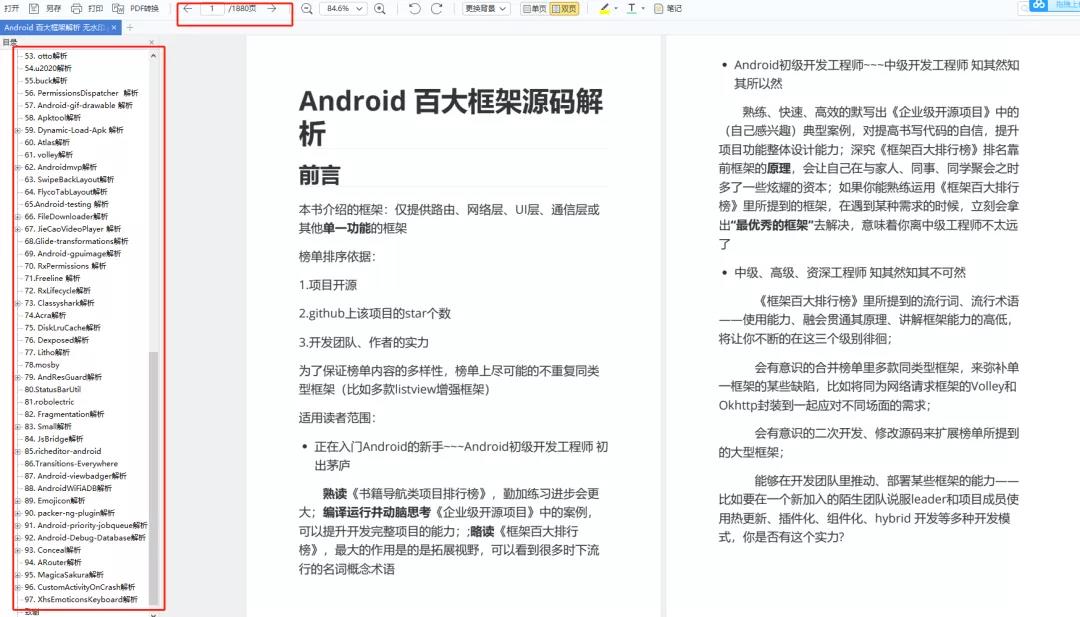
四、高级kotlin强化实战
1、Kotlin入门教程
2、Kotlin 实战避坑指南
3、项目实战《Kotlin Jetpack 实战》
-
从一个膜拜大神的 Demo 开始
-
Kotlin 写 Gradle 脚本是一种什么体验?
-
Kotlin 编程的三重境界
-
Kotlin 高阶函数
-
Kotlin 泛型
-
Kotlin 扩展
-
Kotlin 委托
-
协程“不为人知”的调试技巧
-
图解协程:suspend
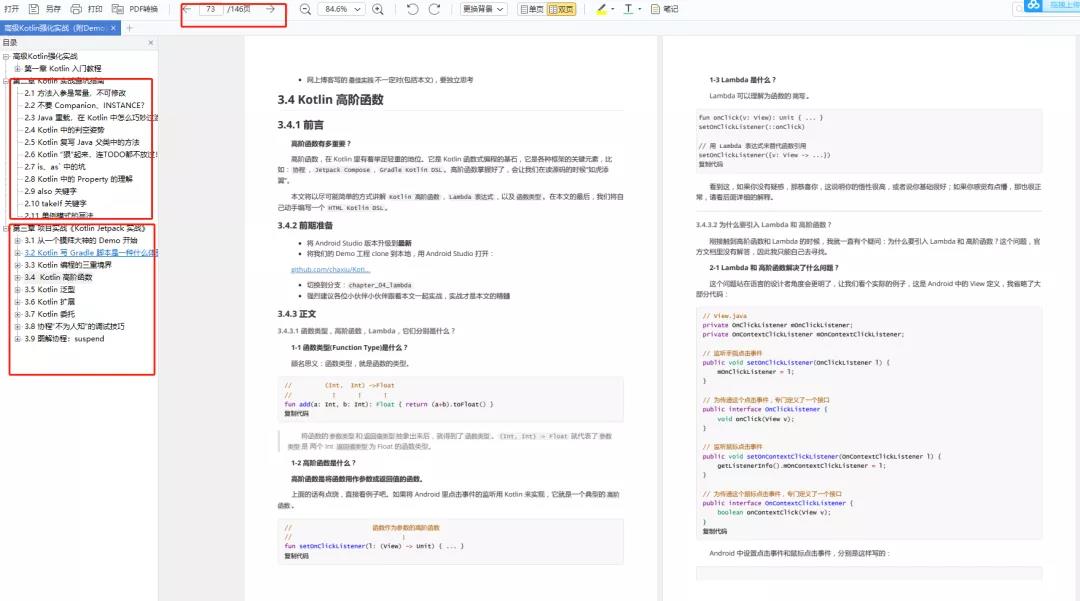
五、Android高级UI开源框架进阶解密
1.SmartRefreshLayout的使用
2.Android之PullToRefresh控件源码解析
3.Android-PullToRefresh下拉刷新库基本用法
4.LoadSir-高效易用的加载反馈页管理框架
5.Android通用LoadingView加载框架详解
6.MPAndroidChart实现LineChart(折线图)
7.hellocharts-android使用指南
8.SmartTable使用指南
9.开源项目android-uitableview介绍
10.ExcelPanel 使用指南
11.Android开源项目SlidingMenu深切解析
12.MaterialDrawer使用指南
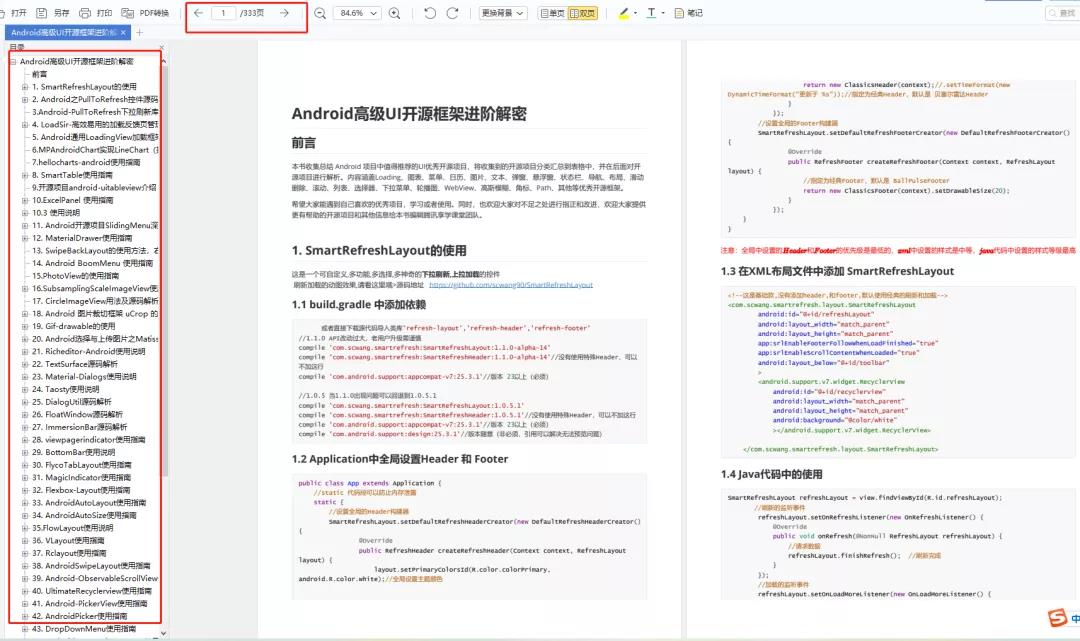
六、NDK模块开发
1、NDK 模块开发
2、JNI 模块
3、Native 开发工具
4、Linux 编程
5、底层图片处理
6、音视频开发
7、机器学习
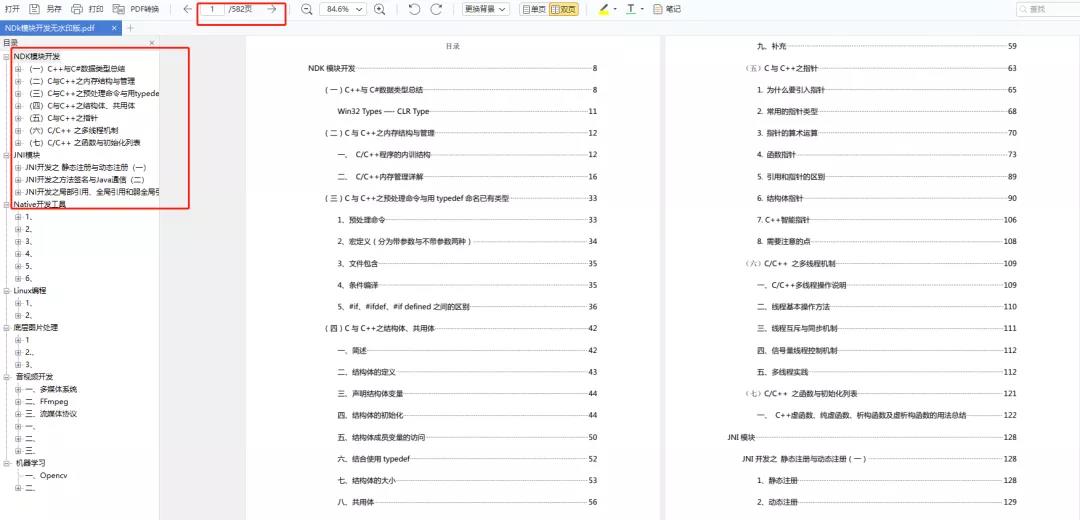
七、Flutter技术进阶
1、Flutter跨平台开发概述
2、Windows中Flutter开发环境搭建
3、编写你的第一个Flutter APP
4、Flutter开发环境搭建和调试
5、Dart语法篇之基础语法(一)
6、Dart语法篇之集合的使用与源码解析(二)
7、Dart语法篇之集合操作符函数与源码分析(三)
…
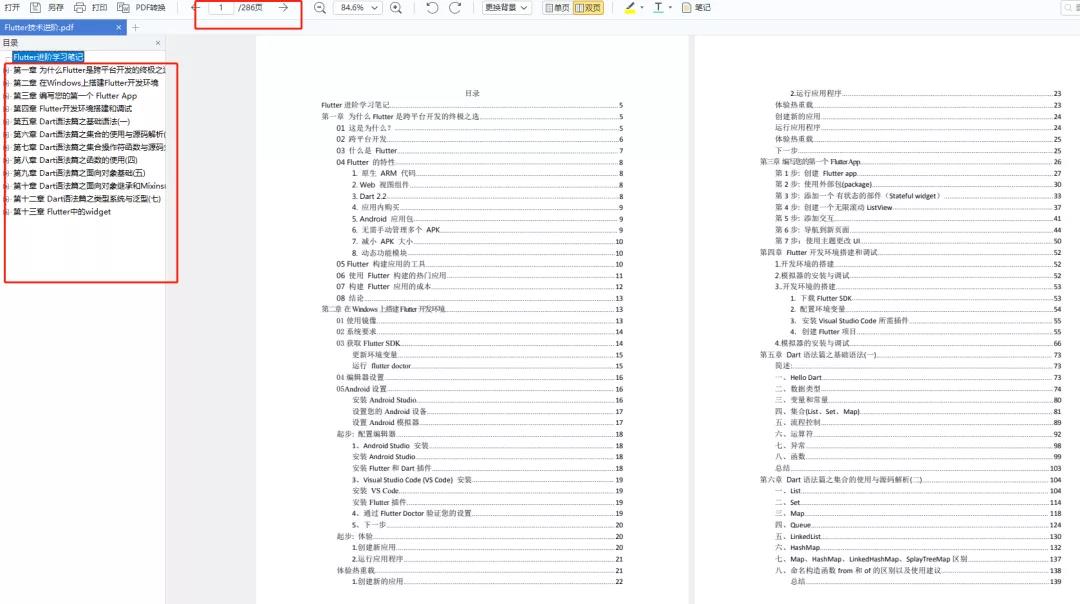
八、微信小程序开发
1、小程序概述及入门
2、小程序UI开发
3、API操作
4、购物商场项目实战……

全套视频资料:
一、面试合集
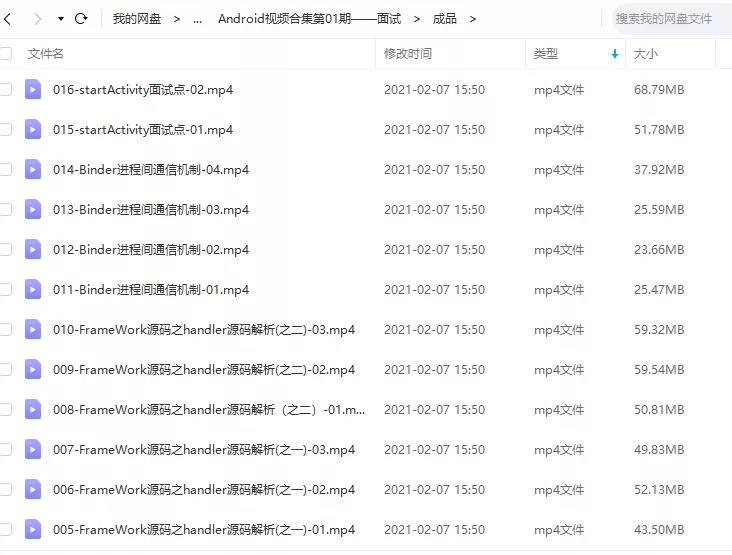
二、源码解析合集
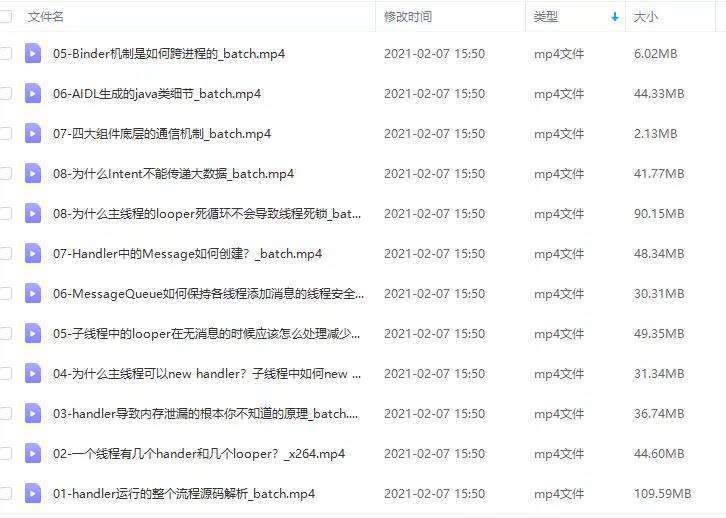
三、开源框架合集
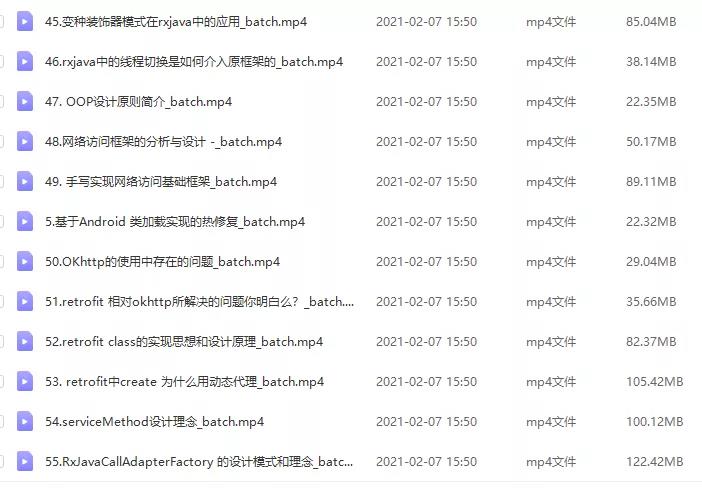
欢迎大家一键三连支持,若需要文中资料,直接点击文末CSDN官方认证微信卡片免费领取【保证100%免费】↓↓↓

 开发者涨薪指南
开发者涨薪指南
 48位大咖的思考法则、工作方式、逻辑体系
48位大咖的思考法则、工作方式、逻辑体系
以上是关于Android WIFI 模块解析的主要内容,如果未能解决你的问题,请参考以下文章
借助ESP8266 WIFI模块,实现Android手机有人网络调试助手(或Android手机网络调试助手)与单片机互相通信。
解析-ESP01模块开发Arduino物联网wifi开关模块
[android开发篇][ wifi模块] [3] wifiConnectAndCheck